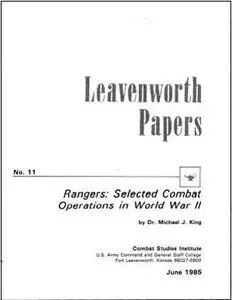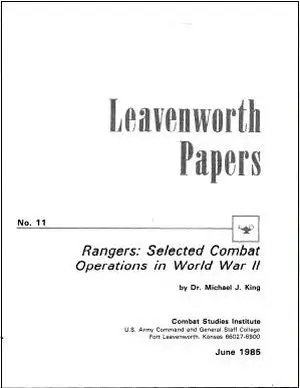Dr. Michael J. King - Rangers. Selected Combat Operations in World War II
Combat Studies Institute | 1985 | ASIN: B001RDM43A | English | 91 pages | PDF | 13.1 MB
Leavenworth Papers No. 11
Combat Studies Institute | 1985 | ASIN: B001RDM43A | English | 91 pages | PDF | 13.1 MB
Leavenworth Papers No. 11
Operation Urgent Fury, conducted In October 1983, focused international attention on the US Army Rangers. This tough, highly mobile force performed an airborne-airland assault into Grenada on short notice and quickly seized objectives while sustaining only limited casualties. The performance of the Rangers in Grenada is indicative of the role that skilled forces can play in a nation's military strategy and exemplifies the deal use of highly trained "elite" forces. The U S Army Ranger has a proud heritage dating from Rogers' Rangers to the present, but at no time was the Rangers' legacy more evident than during the heyday of World War II. Conceived under the guidance of then Army Chief of Staff, General George C Marshall, the Rangers were selectively recruited and trained for operations such as raids, infiltrations, and specialized combat. In reality their utilization was somewhat more varied thus providing one of the themes for this Leavenworth Paper. The five Ranger operations recounted in this paper depict the Rangers in a variety of combat roles. Each operation provided unique challenges to the Ranger Force, and each produced different results. Created for one purpose, often used and misused for others, the Ranger organization fluctuated throughout the war. The longer the Ranger Force remained in a theater of operations, the heavier it became and the more likely it was to be employed in a conventional role. The Ranger leadership constantly struggled with organizational problems in its attempts to balance the need for additional firepower aid combat power with the need to retain its identity as a light mobile flexible strike force. The evolutional process depicted in this paper illustrates the difficulties encountered by military units that are given inappropriate missions for their force capability. When the Rangers were utilized in their designed roles in appropriate missions and within organizational constraints they achieved outstanding successes. When these organizational constraints were ignored and Rangers were used in a conventional role, disaster resulted as at Cisterna when the Rangers were unable to counter the German armor threat. In Rangers: Selected Combat Operations in World War II, Dr Michael J. King presents a multifaceted work that blends battle narrative operational lessons and doctrinal considerations into a paper that provides a useful historical perspective into Ranger operations. The relevance of these historical case studies to current and future elite force operations is evident. Force designers, doctrine writers, and commanders will greatly profit from the valuable information contained In this Leavenworth Paper. One needs only to study these lessons and apply them. Robert W. Riscassi Lieutenant General, USA Commandant.



